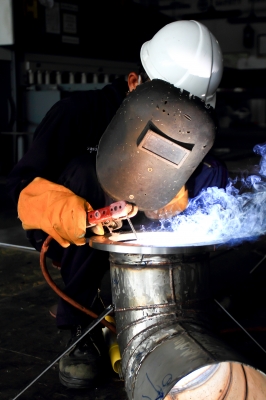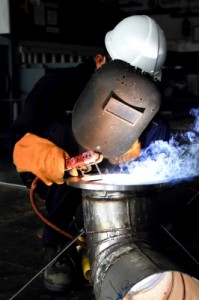By Holly A. Bell
While I understand and accept the arguments for why globalization is a positive thing—higher wages and a growing global middle-class, lower cost of goods, and more goods available through specialization and trade (just to name a few)—an increasingly globalized manufacturing sector gives me cause for concern about competitive advantage in the United States.
Should manufacturing be the next era in our industrial evolution?
Readers of this blog recognize I am a free-trade capitalist who believes in competition, but like most people who identify themselves as such, I’m not a cold-hearted snake. I recently read an excellent, yet disturbing, New York Times article that discusses why Apple is so pleased with their decision to move manufacturing from the United States to China. Their reasons? Here’s a hint, they didn’t mention the cost of labor as you might expect, although it is most likely a consideration. They point to the availability of an eager, hardworking, and flexible workforce (and plenty of it) as well as China’s ability to deliver and hire highly skilled employees, like engineers, incredibly quickly. But here is the disturbing part, the article states:
“Apple executives say that going overseas, at this point, is their only option. One former executive described how the company relied upon a Chinese factory to revamp iPhone manufacturing just weeks before the device was due on shelves. Apple had redesigned the iPhone’s screen at the last minute, forcing an assembly line overhaul. New screens began arriving at the plant near midnight.
A foreman immediately roused 8,000 workers inside the company’s dormitories, according to the executive. Each employee was given a biscuit and a cup of tea, guided to a workstation and within half an hour started a 12-hour shift fitting glass screens into beveled frames. Within 96 hours, the plant was producing over 10,000 iPhones a day.
‘The speed and flexibility is breathtaking,’ the executive said. ‘There’s no American plant that can match that.’”
While they are impressed with their “speed and flexibility” there seems to be no concern for the fact that these workers are being warehoused in dormitories to be called out at a moments notice. OK, while my gut reaction to this was to be quite appalled as it smacks of something slightly above slavery, a little historical perspective was helpful. China is in a much different stage of its industrial evolution than the United States and frankly this environment doesn’t sound that far removed from the early industrial revolution in the United States. It doesn’t mean I like it, it just means I can see why it is happening.
The people of China are not as concerned with their quality of life as we are in the United States, that’s something that evolves once your basic needs for food, clothing and shelter are being met on a regular basis. In China, they’re still just trying to survive. I would add, however, that the situation in China is compounded by the Communist regime that views people as little more than another natural resource to be utilized as the government sees fit without much concern for human rights. That will make the evolution to the next stage of industrial development—the labor relations and workers rights era—somewhat difficult in China perhaps delaying it for a significant period of time. But they will eventually get there.
So assuming the current labor environment in China is simply a point on their industrial evolution timeline (perhaps disturbing to those of us living in developed and more evolved industrial societies but part of their natural progression) my concern becomes this: How do we compete with that? The answer has been to compete in the areas within which we have a competitive advantage. Areas like innovation, technology, and medicine. We also see new industries emerge that replace the manufacturing sector like the transportation sector that has been growing in response to our import-dependent society. I think this is all great and once again a natural part of our industrial evolution.
But here’s the reality, we can’t all be knowledge workers and jobs for unskilled laborers are shrinking overall. I also believe a strong industrial base is an essential national security issue. While we are less likely to go to war with a country we have a significant trading relationship with, we do transfer a considerable amount of power to a place like China when we become too dependent on them to produce our goods. This might also be one motivation to subsidize the auto, steel, and rail transportation industries in the U. S. Going to war without steel or the ability to produce and transport tanks would be a bad idea. Transferring production of your electronics and other products has similar risks, not to mention the passive technology transfer that is taking place, but that’s another post entirely.
While I think there are some legitimate reasons to want manufacturing to return to the U.S., the primary issue is how to compete in this sector. The first ugly reality is that by competing with a country that is at a lower level in their industrial evolution, we get knocked back a bit in that sector. That means we are going to have to be willing to work for lower wages than at our peak. Of course there’s nothing like a prolonged recession with high unemployment to make us willing to work for less. Remember, we’re rebuilding and it will get better.
It also means revisiting our work ethic. I worked as a laborer in the manufacturing sector in the 1980s and many of the people I worked with were less than enthusiastic about their jobs. Those (and other) manufacturing jobs are gone now, and the town has suffered greatly as a result. It is interesting to return to that town and hear people long for the jobs they complained about so much at the time. To compete in this sector we are going to have to work hard and compete on the quality of our labor, which requires enthusiasm. We need to remember there is a long history of great dignity and a deep, hardworking spirit in manufacturing in the U.S. Let’s bring that back.
What can government do? Apple has suggested reforming visa programs to allow companies to hire foreign engineers, as the U.S. has not been able to produce enough to meet the needs of industry. Corporate income tax reform will also be necessary. Perhaps offering companies a significant tax break if they bring overseas profits back to the U.S. to develop domestic manufacturing would be a start. And, as a reader of this blog suggested, the regulatory environment needs to be revisited.
The good news is the declining value of the dollar makes manufacturing in the U.S. and exporting to other markets significantly more competitive. Our prolonged recession has reignited the American work ethic, given us an appreciation for what we have lost, and encouraged workers to improve their skills once again making us the most qualified and productive workforce in the world. The time is right to start moving manufacturing back to the U.S. No, we won’t allow ourselves to be warehoused in dormitories, but we will be innovative in our approach to our work and be strategic partners and not simply cogs in the manufacturing wheel.
We’re ready for the re-manufacturing stage of the industrial evolution.
Image courtesy of Sujin Jetkasettakorn


Having worked in the industrial sector my entire career I can tell you from experience that American Manufacturing can compete globally. We have, in most cases, some of the highest quality goods. Where we are losing is not in labor, but the ever increasing regulatory environment. As a Sourcing Manager this year, a full third of my spend is in areas of regulatory compliance. In my case this is over $60M for my small division of the evil multinational. We have a fab plant in PA, our average hourly wage is about $25 per hour. Benefits are roughly another third of that. However, when you add in everything else required to have that facility operate, the fully burdened rate charged out to customers climbs to over $100 per hour and makes it very difficult to compete.
I hear you Jennifer! I think the time is right for change and movement in the right direction to fix this. We can compete and we need to start trying…
Pingback: The Interview, It’s Not As Bad As It Seems | Holly Bell's Blog
Pingback: » The Economic and Geo-Political Implications of China-Centric Globalization The Tolling Bell
Pingback: » Europe crisis could halve China’s growth: IMF The Tolling Bell
Pingback: Manufacturing: America’s Next Industrial Evolution? « Economics Info
Pingback: » Manufacturing Intelligence and National Security The Tolling Bell